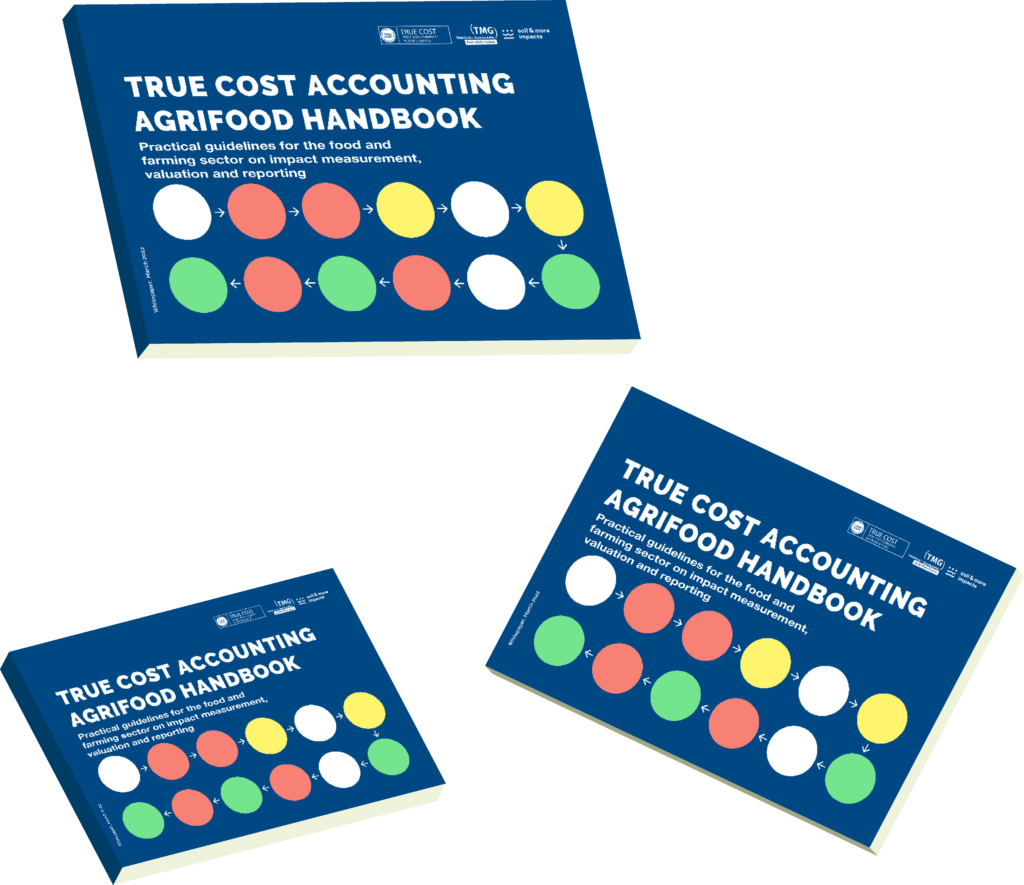
True Cost – From Costs to Benefits in Food and Farming
Impact accounting methodology for the food and agriculture sector
What is
True Cost Accounting?
True Cost Accounting (TCA) is a new way of identifying the real costs of a specific product or service. TCA calculates not only the direct costs like raw materials and labour, but also the effects on the natural and social environment in which a company operates.
We are already paying in hidden ways
The predominant approaches to food production, distribution, retail and consumption are causing significant damage to the environment (soil, water, biodiversity, climate) as well as to rural communities and to public health.
We pay for this damage in both hidden and visible ways, for instance through water charges which include the cost of removing pesticides in drinking water, or taxes which fund misdirected agricultural subsidies and environmental clean-up costs, including many of those related to flooding.
These costs are often deferred to future generations or other countries, as is currently the case with climate change, soil degradation, rainforest destruction and species extinction. We are also paying the costs of diet-related diseases.
Although food appears to have never been cheaper, when we look beneath the surface we are actually paying far more for it than we might possibly imagine
How does TCA work?
TCA not only looks at a company’s usual financial figures, but also calculates its impact on the entire environment in which it operates. These effects are calculated in monetary terms so the amounts can be incorporated in the True Cost books of a company. The “hidden costs” of production, which in the old system were externalised, are made visible and internalised.
Until now there have only been high level, mostly theoretical frameworks for TCA which consist mainly of process descriptions with no suggestions for indicators and data. These lack consistency as well as the ability to compare the underlying metrics. Hence the information on sustainability cannot be integrated with businesses’ financial data.
The “True Cost – From Costs to Benefits in Food and Farming” initiative addresses these problems by developing internationally applicable handbook for TCA. It presents an innovative methodology for businesses in food production to calculate the true costs of food products. Our pilot projects have shown that there is a holistic and practical way to account for the social and environmental impacts of food production.
How to uncover the true cost?

In this video Raunak R. Jain, the owner of the Indian Eucalyptus company, shares his experiences and learnings from piloting True Cost Accounting together with PRIMAVERA.
What is the added value of the handbook?
- The TCA handbook closes the gap between financial and sustainability information allowing for reporting which captures all of a businesses‘ impacts.
- The handbook provides a detailed description of indicators, monetisation factors, data collection and reporting of social, environmental and health impacts.
- The handbook is tested and evaluated in real businesses. It works for all types of agricultural raw materials, in many agricultural settings and for various types of value chains.
- The handbook instructs businesses how to measure today’s impacts in order to manage tomorrow’s risks, and reduce tomorrow’s costs.
- The handbook provides a baseline for comparing business impacts and for establishing a standardised model for impact assessment and reporting.
Who can use the TCA handbook?

Farmers and food businesses can assess and evaluate their impacts and risks, and use the handbook for sustainability accounting and reporting. TCA provides transparency and clarity for customers, creditors and other stakeholders.

Banks and other financial institutions can use TCA to compare the sustainability performance of businesses. TCA can be used to design investment and eligibility criteria which will help fund sustainable business models that take into account social, environmental and economic costs.

The handbook represents a starting point for further development of the concept of TCA, and provides orientation for the development of the methodology for other industries. TCA can be used to develop ideas and possible pathways to sustainable food systems.


Consultants and accountants can use the handbook to support businesses with the implementation of TCA, and base strategic business advice on the results.

Do you have any questions about the handbook?


True Cost – From Costs to Benefits in Food and Farming
Impact accounting methodology for the food and agriculture sector
True Cost Accounting?
True Cost Accounting (TCA) is a new way of identifying the real costs of a specific product or service. TCA calculates not only the direct costs like raw materials and labour, but also the effects on the natural and social environment in which a company operates.
We are already paying in hidden ways
The predominant approaches to food production, distribution, retail and consumption are causing significant damage to the environment (soil, water, biodiversity, climate) as well as to rural communities and to public health.
We pay for this damage in both hidden and visible ways, for instance through water charges which include the cost of removing pesticides in drinking water, or taxes which fund misdirected agricultural subsidies and environmental clean-up costs, including many of those related to flooding.
These costs are often deferred to future generations or other countries, as is currently the case with climate change, soil degradation, rainforest destruction and species extinction. We are also paying the costs of diet-related diseases.
Although food appears to have never been cheaper, when we look beneath the surface we are actually paying far more for it than we might possibly imagine
How does TCA work?
TCA not only looks at a company’s usual financial figures, but also calculates its impact on the entire environment in which it operates. These effects are calculated in monetary terms so the amounts can be incorporated in the True Cost books of a company. The “hidden costs” of production, which in the old system were externalised, are made visible and internalised.
Until now there have only been high level, mostly theoretical frameworks for TCA which consist mainly of process descriptions with no suggestions for indicators and data. These lack consistency as well as the ability to compare the underlying metrics. Hence the information on sustainability cannot be integrated with businesses’ financial data.
The “True Cost – From Costs to Benefits in Food and Farming” initiative addresses these problems by developing internationally applicable handbook for TCA. It presents an innovative methodology for businesses in food production to calculate the true costs of food products. Our pilot projects have shown that there is a holistic and practical way to account for the social and environmental impacts of food production.
How to uncover the true cost?

In this video Raunak R. Jain, the owner of the Indian Eucalyptus company, shares his experiences and learnings from piloting True Cost Accounting together with PRIMAVERA.
What is the added value of the handbook?
- The TCA handbook closes the gap between financial and sustainability information allowing for reporting which captures all of a businesses‘ impacts.
- The handbook provides a detailed description of indicators, monetisation factors, data collection and reporting of social, environmental and health impacts.
- The handbook is tested and evaluated in real businesses. It works for all types of agricultural raw materials, in many agricultural settings and for various types of value chains.
- The handbook instructs businesses how to measure today’s impacts in order to manage tomorrow’s risks, and reduce tomorrow’s costs.
- The handbook provides a baseline for comparing business impacts and for establishing a standardised model for impact assessment and reporting.
Who can use the TCA handbook?

Farmers and food businesses can assess and evaluate their impacts and risks, and use the handbook for sustainability accounting and reporting. TCA provides transparency and clarity for customers, creditors and other stakeholders.

Banks and other financial institutions can use TCA to compare the sustainability performance of businesses. TCA can be used to design investment and eligibility criteria which will help fund sustainable business models that take into account social, environmental and economic costs.

The handbook represents a starting point for further development of the concept of TCA, and provides orientation for the development of the methodology for other industries. TCA can be used to develop ideas and possible pathways to sustainable food systems.

Insurance conditions, industry and business specific risks can be determined based on TCA.


Do you have any questions about the handbook?


